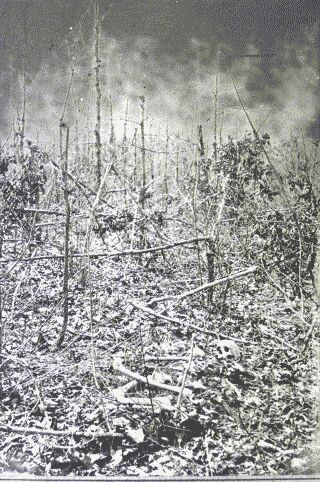| On
May 2nd, Lee called his commanders together and advised he thought the Federal
Army, now under General Grant, would make a move across the Rapidan in the
near future. Sure enough, two days later, scouts on Clark's Mountain signalled
Grant's men were on the move. By 1:00 pm on the 4th, Hill's men were enroute
to intercept. With Ewell's Corps advancing toward the Wilderness on the Orange
Turnpike, Hill's forces moved up the Orange Plank Road in the same direction.
This was the same Wilderness area that Lee had won such a glorious victory
at the Battle of Chancellorsville. Now, with 64M men, he faced a Union force
of over 120M, and a new commander. Ewell's forces were the first to make contact, on what would become Lee's left flank. Realizing Hill's men could cut off an entire corps if they were able to make it to the Brock Road intersection, Grant sent in Getty's Division from the VI Corps to hold it. The battle on the right flank would become a see-saw battle in forest that limited visibility to 20 yards. Initially, Hill's front division under Heth successfully pushed the Union forces back. When reinforcements from Hancock's 2nd Corps began arriving, the tide shifted. Wilcox's division was by now, located around the Chewning farm, an unwooded high spot in the center. It was here that Hill's forces joined with Ewell's right flank. Two of Wilcox's brigades were sent to reinforce Heth, while Thomas Georgian's maintained their support of Poague's battalion of artillery.
As
more and more of Hancock's men arrived and were rushed into the battle against
Hill, Thomas' brigade was sent to reinforce Kirkland's North Carolinian's
under Heth, who were under heavy attack. Thomas sent his men charging into
a Federal column, only to receive heavy fire from their flank. Soon they
were nearly surrounded in the forest, fighting at right angles to one another,
and in some cases, back to back. As darkness fell, the firing began to cease.
Hill had escaped disaster against overwhelming odds; his 15,000 men holding
back 40,000 Federal's. Every armed man he had was on the line now. He had
even robbed Gen Lee's 5th Alabama, a decimated regiment of only 125 men,
now assigned to provost marshal duties. These men had completely fooled
Wadsworth's Iron Brigade into believing they were a much larger force, and
secured the gap between Ewell and Hill.
Monument near Widow Tapp Farm...field located near where Thomas' men fought in woods.
The
situation became so perilous, that when Union forces broke into a clearing,
Hill had to order artillery to fire over and into his own men to stop their
advance. This momentarily stopped the Union advance, but as they swung around
to flank the cannons, and all seemed loss, Longstreet's men poured up the
road. It was a complete reversal of Antietam. There, Hill's last minute arrival
had kept Longstreet's Corps from collapsing. Now, for a second time, Lee
had come within a hair's breath of losing the war. But this time, it was
Longstreet who arrived in the nick of time. Led by his Texan's, Longstreet's
men turned off the road, and under fire, formed into position. After advancing
nearly 1000 yards, and now completely disorganized, Hancock's men could not
handle Longstreet's attack. Within minutes,it was the Union forces in hasty
retreat as Longstreet's men poured into the forest after them. Hill's men,
quickly reorganized, were sent to protect the center between Ewell and
Longstreet. There they found the Union IX Corps and attacked. On the left,
Ewell attacked. Throughout the remainder of the day, the battle raged. When
night fell for a second time on the battlefield, the two armies were basically
where they had started. On May the 7th, scouts reported Grant was pulling
out, but unlike all Union commanders before him, was not withdrawing. Instead
he was heading toward Spotsylvania.
The
battle had gained neither army anything but casualties. Grant's army suffered
nearly 16M casualties, while Lee's Army of Northern Virginia had suffered
over 11M. Hill had lost nearly half his corps, with 7000 of his 15000 men,
dead, wounded, or missing. The 35th Georgia would loose 4 killed, 22 wounded
and 23 missing in the engagement. Exactly who the 35th was facing in this
battle is impossible to determine at this time, if ever. Troops were faced
in different directions, and tangled in the heavy woods. Even batle maps
are unclear on the location of the Geogian's under Thomas> Even General
Hancock in his official report stated "No movements of the enemy could
be observed until the lines were almost in collision; only the roar of the
musketry disclosed the position of the combatants" Battle of the Wilderness Links Drawing of Battlefield, 1st Day early, Lee's right flank only shown |

